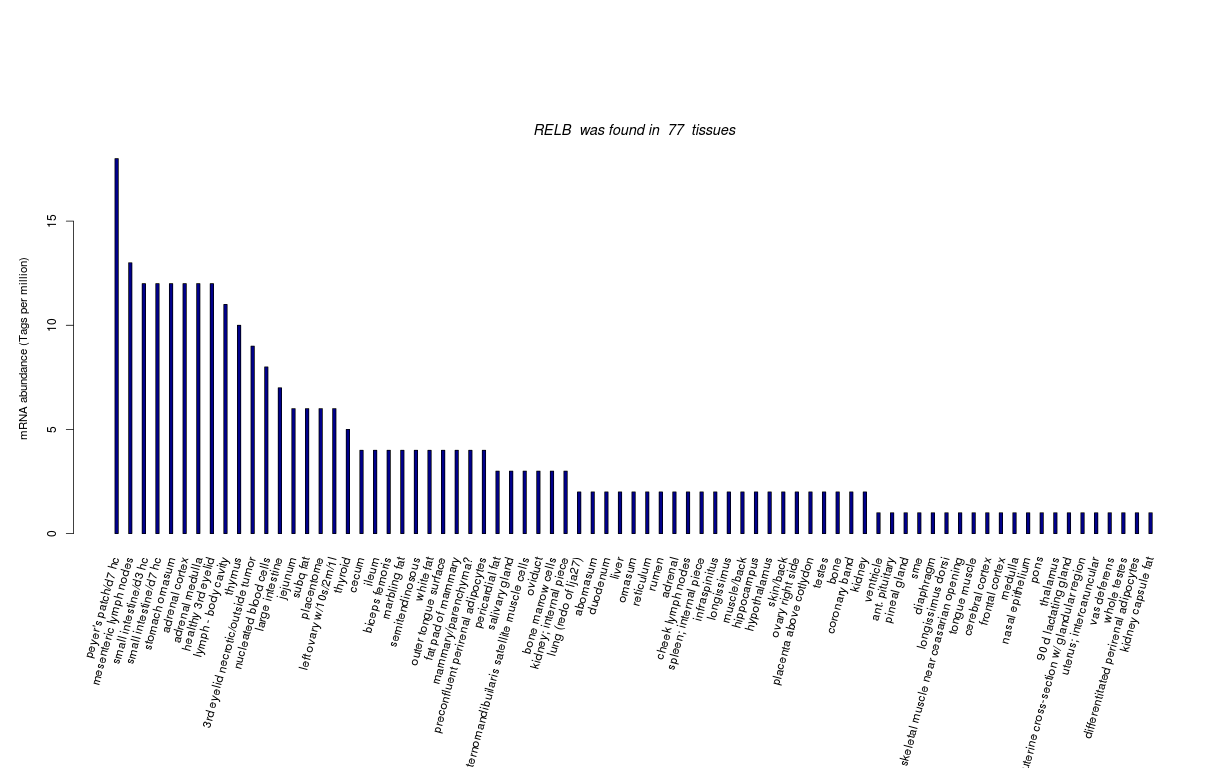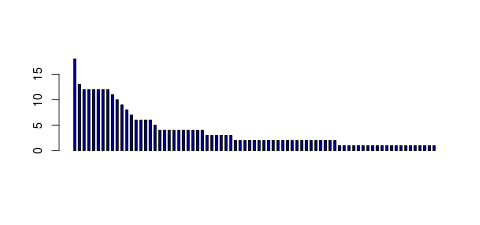| Bos taurus Gene: RELB | |||||||||||||||
|---|---|---|---|---|---|---|---|---|---|---|---|---|---|---|---|
| Summary | |||||||||||||||
| InnateDB Gene | IDBG-639330.3 | ||||||||||||||
| Last Modified | 2014-10-13 [Report errors or provide feedback] | ||||||||||||||
| Gene Symbol | RELB | ||||||||||||||
| Gene Name | Uncharacterized protein | ||||||||||||||
| Synonyms | |||||||||||||||
| Species | Bos taurus | ||||||||||||||
| Ensembl Gene | ENSBTAG00000038428 | ||||||||||||||
| Encoded Proteins |
v-rel reticuloendotheliosis viral oncogene homolog B
v-rel reticuloendotheliosis viral oncogene homolog B
|
||||||||||||||
| Protein Structure | |||||||||||||||
| Useful resources | Stemformatics EHFPI ImmGen | ||||||||||||||
| InnateDB Annotation from Orthologs | |||||||||||||||
| Summary |
[Homo sapiens] RELB is a NF-kappaB subunit that participates in endotoxin tolerance by repressing pro-inflammatory gene expression.
[Homo sapiens] RELB mediates transcription of chemokines like IL8 via activation of AHR and Protein kinase A, and its expression is inhibited by Vitamin D3 analog in DCs.
[Homo sapiens] RELB acts as both transcription factor as well as a repressor of NF-kappaB gene expression by forming heterodimers with NFKB1 (p50 subunit) and NFKB2 (p100 subunit) or inhibiting RELA DNA binding activity, respectively.
[Homo sapiens] RELB sustains NFKBIA (IkappaB alpha) expression during endotoxin tolerance, RelB transcription activation requires binding to the (IkappaB alpha) proximal promoter along with NFKB1 (p50), and is associated with an apparent dimer exchange with RELA (p65).
[Homo sapiens] RELB functions as a dual transcription regulator during LPS tolerance and human severe systemic inflammation (SSI) by activating and repressing innate immunity genes.
[Homo sapiens] RELB is required for IL17A production in T cell in response to bacterial infection. RELB deficient T cells resulted in a diminished innate immune response to E. coli infection. (Demonstrated in murine model)
[Mus musculus] Relb is required for Il17a production in T cell in response to bacterial infection. Relb deficient T cells resulted in a diminished innate immune response to E. coli infection.
[Mus musculus] Ripk3 has a novel function in NF-kB activation, dendritic cell biology, innate inflammatory-cytokine expression, and injury-induced tissue repair.
|
||||||||||||||
| Entrez Gene | |||||||||||||||
| Summary |
This gene does not have any Entrez summary - the following is the summary from its human ortholog ENSG00000104856:
|
||||||||||||||
| Gene Information | |||||||||||||||
| Type | Protein coding | ||||||||||||||
| Genomic Location | Chromosome 18:53099825-53127762 | ||||||||||||||
| Strand | Forward strand | ||||||||||||||
| Band | |||||||||||||||
| Transcripts |
|
||||||||||||||
| Interactions | |||||||||||||||
| Number of Interactions |
This gene and/or its encoded proteins are associated with 0 experimentally validated interaction(s) in this database.
They are also associated with 118 interaction(s) predicted by orthology.
|
||||||||||||||
| Gene Ontology | |||||||||||||||
Molecular Function |
|
||||||||||||||
| Biological Process |
|
||||||||||||||
| Cellular Component |
|
||||||||||||||
| Orthologs | |||||||||||||||
|
Species
Homo sapiens
Mus musculus
|
Gene ID
Gene Order
|
||||||||||||||
| Pathway Predictions based on Human Orthology Data | |||||||||||||||
| NETPATH |
TNFalpha pathway
RANKL pathway
TSLP pathway
TWEAK pathway
|
||||||||||||||
| REACTOME | |||||||||||||||
| KEGG |
MAPK signaling pathway pathway
Osteoclast differentiation pathway
MAPK signaling pathway pathway
Osteoclast differentiation pathway
|
||||||||||||||
| INOH | |||||||||||||||
| PID NCI |
IL12-mediated signaling events
Alternative NF-kappaB pathway
|
||||||||||||||
| Cross-References | |||||||||||||||
| SwissProt | |||||||||||||||
| TrEMBL | F1MBB0 | ||||||||||||||
| UniProt Splice Variant | |||||||||||||||
| Entrez Gene | 522670 | ||||||||||||||
| UniGene | Bt.17669 | ||||||||||||||
| RefSeq | XM_002695167 XM_600955 | ||||||||||||||
| HUGO | HGNC:9956 | ||||||||||||||
| OMIM | |||||||||||||||
| CCDS | |||||||||||||||
| HPRD | |||||||||||||||
| IMGT | |||||||||||||||
| EMBL | DAAA02047344 | ||||||||||||||
| GenPept | |||||||||||||||
| RNA Seq Atlas | 522670 | ||||||||||||||
| Transcript Frequencies | |||||||||||||||
| Tag Count based mRNA-Abundances across 87 different Tissues (TPM).
Based on Data from Bovine Gene Atlas |
(Move your mouse over the image to view a more detailed version) |
||||||||||||||


